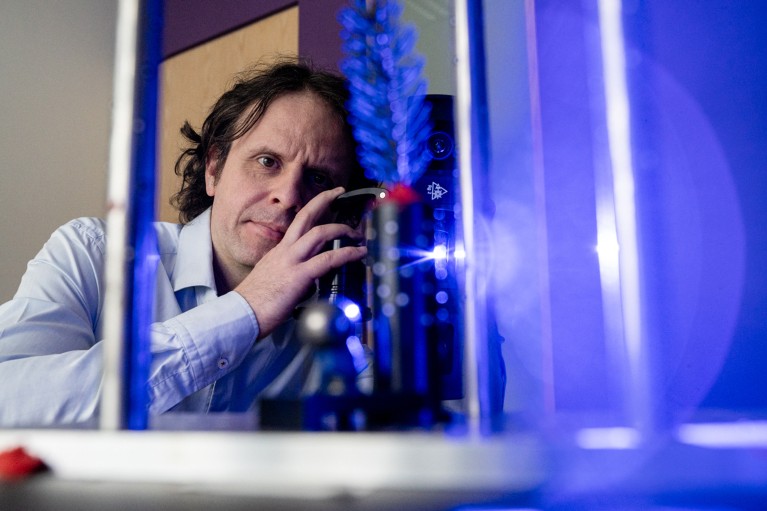Hello Nature readers, would you like to get this Briefing in your inbox free every day? Sign up here.

A Long March 5 rocket, carrying the Chang’e-6 lunar probe, lifts off in the rain at the Wenchang Space Launch Centre in China.Credit: Hector Retamal/AFP via Getty
Lift-off: Chang’e-6 heads for the Moon
The China National Space Administration has successfully launched the first mission to collect material from the far side of the Moon. If all goes according to plan, scientists will be examining the first rocks by late June. It “will be like a treasure chest”, says planetary scientist Bradley Jolliff. “The samples collected will be analysed for decades to come.”
Read more: what China’s mission to collect rocks from the Moon’s far side could reveal (Nature | 7 min read)
Argentina’s nuclear research at risk
Argentina’s nuclear sector — which includes power plants and research facilities — is at risk from massive budget cuts and lay-offs of government employees, scientists say. Some fear that the country will lose its place in the ‘nuclear club’, which it gained after becoming the first in Latin America to adopt nuclear energy. The situation is another consequence of the policies of far-right president Javier Milei, who has pledged to reduce public funding for science to help get to grips with the country’s economic crisis.
US ban stifles China’s AI progress
China’s AI sector could be five to ten years behind the United States, partly because it can’t access the most advanced computer chips. In 2022, the United States imposed export controls on the fastest chips and on equipment that could be used to produce such chips. Even foreign suppliers that produce chips for the US market won’t sell to Chinese developers to avoid falling foul of US sanctions. This has “dramatically limited” China’s progress with training AI models, says computer engineer Yiran Chen.
Dinosaur eggs: not too soft, not too hard
Palaeontologists have discovered dinosaur eggs in eastern China that were softer and less brittle than hard-shelled eggs — but not quite soft-shelled either. The eggs, which date back to some 66-145 million years ago, suggest that dinosaurs were more diverse than previously assumed. “There has been a long-running discussion on whether dinosaurs’ shells were hard or soft,” says Zheng Hanghai, the palaeontologist who led the dig. “The deformed eggs add a third element to discussions on the evolution of dinosaur eggs.”
Reference: Cretaceous Research paper
Features & opinion
He changed the way we think about thinking
The work of psychologist Daniel Kahneman, who has died aged 90, led to the rethinking of decision-making in areas as diverse as political negotiations, medical treatment and the recruitment of baseball players, writes behavioural scientist Eldar Shafir. Kahneman and psychologist Amos Tversky showed that decision-making was more often guided by instinct and emotions, than by logic and reason — an approach that won him the Nobel Prize in economics in 2002 and launched the field of behavioural economics. Kahneman enjoyed “adversarial collaborations”, writes Shafir, but remained mild and self-effacing himself. He “was open to the likelihood that he himself was often wrong”.
Grad students go hungry on campus
Food insecurity is “off the scales” in universities, say researchers. Some universities have opened places to get food banks and food pantries, others have group chats to announce where to score free leftovers. As well as lowering academic performance and increasing the risk of depression, food insecurity is associated with social stigma. Nutritional biologist Gwen Chodur helped launch a food pantry specifically for fellow graduate students, some of whom were anxious about going to the one used by undergraduates. “They were saying things like, ‘If I see my students there, that could undermine my authority in the classroom,” she says.
‘Most important letter in dementia research’
In a brisk but affecting thread, science journalist Tom Whipple revisits the tale of Carol Jennings, whose 1986 letter to neurogeneticist John Hardy outlining her family history of Alzheimer’s jump-started the leading theory of the disease. The letter’s outcome, five years later, was an influential Nature paper identifying a genetic mutation linked to the formation of amyloid plaques in the brain, supporting the idea that amyloid contributes to dementia. Recently, two experimental treatments — the monoclonal antibodies donanemab and lecanemab — that target amyloid have been shown to reduce the cognitive decline associated with Alzheimer’s disease, raising hopes for a new era of effective treatments. Jennings — who began to develop symptoms of Alzheimer’s disease in 2008 — died in March, aged 70.
Twitter thread | 3 min read (with some handy paywall-penetrating links to Whipple’s longer coverage in The Times)
Reference: Nature paper (from 1991)
Where I work

Jan Pisek is a physical geographer at Tartu Observatory, the University of Tartu, Estonia.Credit: Marja-Liisa Plats
Physical geographer Jan Pisek uses photogrammetry to create a high-resolution 3D model of a twig of Norway spruce (Picea abies). “The better researchers understand what happens to sunlight when it hits Earth, the better they can estimate its effects on climate,” he says. “Part of this means creating reliable models of what happens when light hits trees.” In this case, much of the simulated sunlight is scattered and then absorbed by the tree’s needles. “In other words, the geometry that the conifers have evolved provides them with extra energy for photosynthesis — and explains why conifer forests often look darker than forests of other trees.” (Nature | 3 min read)
